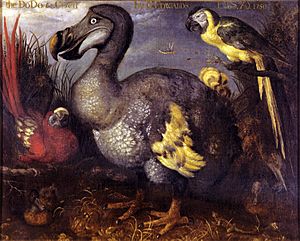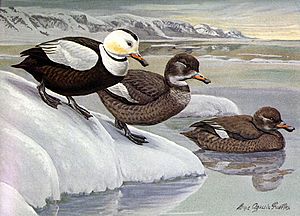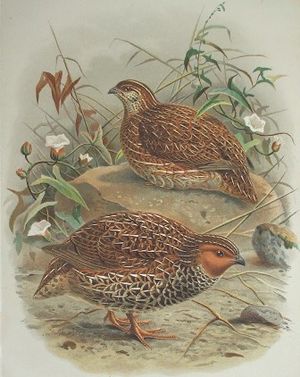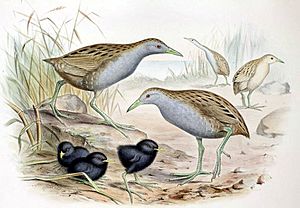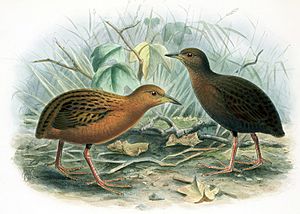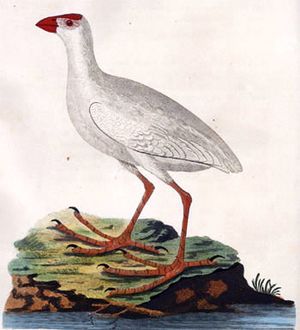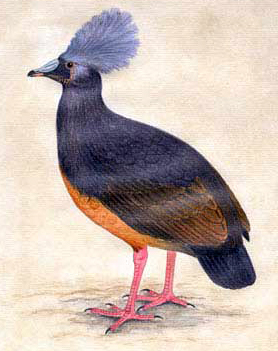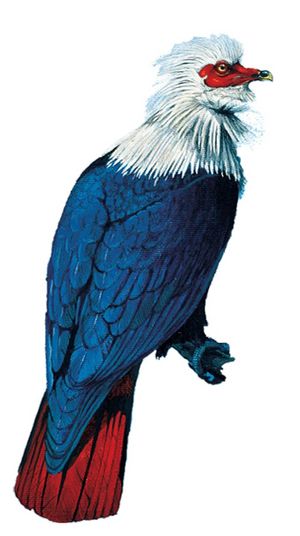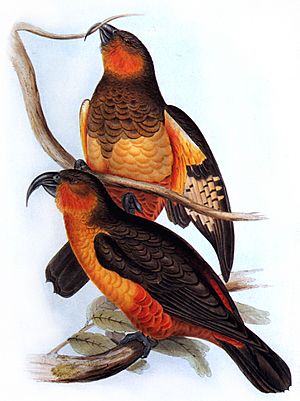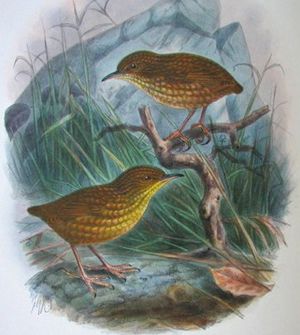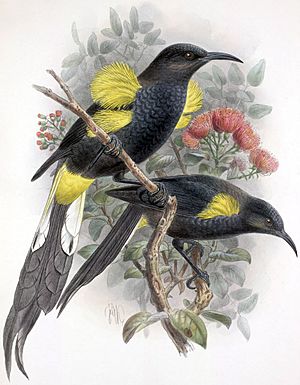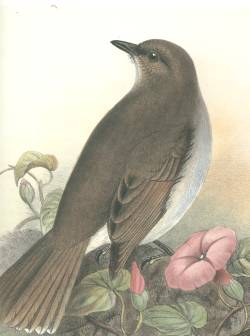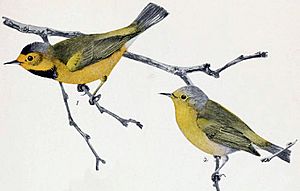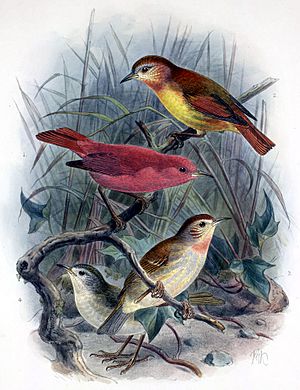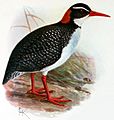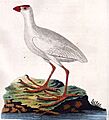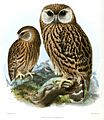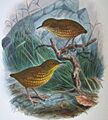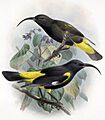List of extinct bird species since 1500 facts for kids
About 129 types of birds have disappeared forever since the year 1500. Sadly, this is happening more and more often. For example, in Hawaii, 30% of all recently extinct birds used to live there. Guam has also lost over 60% of its native birds in the last 30 years. Many of these birds were eaten by the brown tree snake (Boiga irregularis), which was brought to the island.
Today, there are about 10,000 different kinds of birds. More than 1,480 of them are at risk of disappearing, and 223 are in extreme danger. Birds that live on islands, especially those that cannot fly, are most at risk. Many birds called rails have become extinct because they often lose their ability to fly when they live on isolated islands. Some rails disappeared even before scientists could study them.
The dates given for when birds became extinct are usually close guesses. Sometimes, we know the exact year or even day. For many Pacific birds that disappeared after Europeans arrived, it's harder to know the exact date because scientists didn't visit those islands very often.
Contents
- Birds That Are Gone Forever
- Ancient Birds (Paleognathes)
- Ducks, Geese, and Swans (Anseriformes)
- Quails and Relatives (Galliformes)
- Shorebirds, Gulls, and Auks (Charadriiformes)
- Shorebirds (Charadrii)
- Sandpipers and Allies (Scolopaci)
- Auks (Lari)
- Rails and Allies (Gruiformes)
- Grebes (Podicipediformes)
- Petrels, Shearwaters, and Albatrosses (Procellariiformes)
- Penguins (Sphenisciformes)
- Boobies and Related Birds (Suliformes)
- Pelicans and Related Birds (Pelecaniformes)
- Pigeons, Doves, and Dodos (Columbiformes)
- Cuckoos (Cuculiformes)
- Vultures (Cathartiformes)
- Owls (Strigiformes)
- Images for kids
- See also
Birds That Are Gone Forever
Since 1500, many bird species have sadly disappeared. Here are some of them, grouped by their bird families.
Ancient Birds (Paleognathes)
These are some of the oldest types of birds.
Giant Moas (Dinornithiformes)
- Upland moa, Megalapteryx didinus (South Island, New Zealand, late 1400s?)
- South Island giant moa, Dinornis robustus (South Island, New Zealand, late 1400s?)
- Broad-billed moa, Euryapteryx curtus (North and South Island, New Zealand, late 1400s?)
Kiwis (Apterygiformes)
- West Coast spotted kiwi, Apteryx occidentalis (South Island, New Zealand, around 1900)
- This bird is known from only one specimen. It might be a type of little spotted kiwi or a mix of different kiwi types.
Elephant Birds (Aepyornithiformes)
- Giant elephant bird, Aepyornis maximus (Madagascar, 1600s?)
- Hildebrandt's elephant bird, Aepyornis hildebrandti (Madagascar, 1600s?)
- Lesser elephant bird, Mullerornis modestus (Madagascar, 1600s?)
Ducks, Geese, and Swans (Anseriformes)
- Anatidae – This family includes ducks, geese, and swans.
- Anatinae – These are the ducks.
- Shelducks and Sheldgeese
- Crested shelduck, Tadorna cristata (Northeast Asia, late 1900s?)
- Réunion sheldgoose, Alopochen kervazoi (Réunion, Mascarenes, around 1690s)
- Mauritius sheldgoose, Alopochen mauritianus (Mauritius, Mascarenes, around 1695)
- Mergini – These are sea ducks.
- Labrador duck, Camptorhynchus labradorius (northeastern North America, around 1878)
- New Zealand merganser, Mergus australis (New Zealand and Auckland Islands, Southwest Pacific, around 1902)
- Aythyini – These are diving ducks.
- Finsch's duck, Chenonetta finschi (New Zealand, 1400s–1600s)
- Pink-headed duck, Rhodonessa caryophyllacea (East India, Bangladesh, North Myanmar, 1945?)
- This bird is officially listed as critically endangered, but surveys have not found it.
- Réunion pochard, Aythya cf. innotata (Réunion, Mascarenes, around 1690s)
- Anatini – These are dabbling ducks.
- Amsterdam wigeon, Mareca marecula (Amsterdam Island, South Indian Ocean, around 1800)
- Saint Paul Island duck, Anas sp. (St. Paul Island, South Indian Ocean, around 1800)
- Only known from a painting.
- Mascarene teal, Anas theodori (Mauritius and Réunion, Mascarenes, late 1690s)
- Mariana mallard, Anas oustaleti (Marianas, West Pacific, 1981)
- Shelducks and Sheldgeese
- Anatinae – These are the ducks.
Quails and Relatives (Galliformes)
- Megapodiidae – These are megapodes.
- Pile-builder megapode, Megapodius molistructor (New Caledonia)
- Viti Levu scrubfowl, Megapodius amissus (Viti Levu and possibly Kadavu, Fiji)
- Raoul Island scrubfowl, Megapodius sp. (Raoul, Kermadec Islands, 1876)
- This bird disappeared after a volcanic eruption.
- Phasianidae – These are pheasants and their relatives.
- New Zealand quail, Coturnix novaezelandiae (New Zealand, 1875)
- Himalayan quail, Ophrysia superciliosa (North India, late 1800s?)
- This bird is officially critically endangered. It has not been seen for sure since 1876.
Shorebirds, Gulls, and Auks (Charadriiformes)
Shorebirds (Charadrii)
- Haematopodidae – These are oystercatchers.
- Canary Islands oystercatcher, Haematopus meadewaldoi (eastern Canary Islands, East Atlantic, around 1940?)
- Charadriidae – These are plovers and lapwings.
- Javan lapwing, Vanellus macropterus (Java, Indonesia, mid-1900s)
- This bird is officially critically endangered, but it has not been seen since 1940.
Sandpipers and Allies (Scolopaci)
- Scolopacidae – These are sandpipers and their relatives.
- Eskimo curlew, Numenius borealis (northern North America, late 1900s?)
- This bird might still exist. It is officially critically endangered, possibly extinct.
- Slender-billed curlew, Numenius tenuirostris (Western Siberia, early 2000s?)
- This bird might still exist. It is officially critically endangered.
- Christmas sandpiper, Prosobonia cancellata (Kiritimati Island, Kiribati, Central Pacific, 1850s)
- Tahiti sandpiper, Prosobonia leucoptera (Tahiti, Society Islands, South Pacific, 1800s)
- Moorea sandpiper, Prosobonia ellisi (Moorea, Society Islands, South Pacific, 1800s)
- North Island snipe, Coenocorypha barrierensis (North Island, New Zealand, 1870s)
- South Island snipe, Coenocorypha iredalei (South and Stewart Islands, New Zealand, 1964)
Auks (Lari)
Rails and Allies (Gruiformes)
- Antillean cave rail, Nesotrochis debooyi
- Known from old bones. Stories from 1912 might refer to this bird.
- Hawkins's rail, Diaphorapteryx hawkinsi (Chatham Islands, Southwest Pacific, late 1800s)
- Red rail, Aphanapteryx bonasia (Mauritius, Mascarenes, around 1700)
- Réunion rail or Dubois' wood rail, Dryolimnnas augusti (Réunion, Mascarenes, late 1600s)
- Rodrigues rail, Erythromachus leguati (Rodrigues, Mascarenes, mid-1700s)
- Bar-winged rail, Hypotaenidia poecilopterus (Fiji, Polynesia, around 1990)
- Dieffenbach's rail, Hypotaenidia dieffenbachii (Chatham Islands, Southwest Pacific, mid-1800s)
- Tahiti rail, Hypotaenidia pacificus (Tahiti, Society Islands, South Pacific, late 1700s–1800s)
- Wake Island rail, Hypotaenidia wakensis (Wake Island, Micronesia, 1945)
- Vavaʻu rail, Hypotaenidia vavauensis (Vavaʻu, Tonga, Southwest Pacific, early 1800s?)
- ʻEua rail, Gallirallus vekamatolu
- Known from prehistoric bones.
- Tongatapu rail, Gallirallus hypoleucus (Tongatapu, Tonga, Southwest Pacific, late 1700s or 1800s)
- Hiva Oa rail, Gallirallus sp.
- Norfolk Island rail, Gallirallus sp. (Norfolk Island, Southwest Pacific, early 1600s?)
- Chatham rail, Cabalus modestus (Chatham Islands, Southwest Pacific, around 1900)
- New Caledonian rail, Cabalus lafresnanayanus (New Caledonia, Melanesia, around 1900?)
- This bird is officially critically endangered. Its home has been taken over by feral pigs and wild dogs.
- Ascension crake, Mundia elpenor (Ascension Island, South Atlantic, late 1600s)
- Saint Helena crake, Zapornia astrictocarpus (St. Helena, South Atlantic, early 1500s)
- Laysan rail, Zapornia palmeri (Laysan, Hawaiian Islands, 1944)
- Hawaiian rail, Zapornia sandwichensis (Big Island, Hawaiian Islands, around 1890)
- Kosrae crake, Zapornia monasa (Kosrae, Carolines, mid-to-late 1800s)
- Tahiti crake, Zapornia nigra (Tahiti, Society Islands, South Pacific, around 1800)
- Saint Helena rail, Aphanocrex podarces (St. Helena, South Atlantic, 1500s)
- White swamphen, Porphyrio albus (Lord Howe Island, Southwest Pacific, early 1800s)
- Réunion swamphen or oiseau bleu, Porphyrio coerulescens (Réunion, Mascarenes, 1700s)
- Marquesas swamphen, Porphyrio paepae (Hiva Oa and Tahuata, Marquesas)
- North Island takahē, Porphyrio mantelli (North Island, New Zealand, late 1800s)
- New Caledonian gallinule, Porphyrio kukwiedei (New Caledonia, Melanesia)
- Samoan woodhen, Gallinula pacifica (Savaiʻi, Samoa, 1907?)
- This bird is officially critically endangered. Some people think it might still exist in small numbers.
- Makira woodhen, Gallinula silvestris (Makira, Solomon Islands, mid-1900s?)
- This bird is officially critically endangered. Some people think it might still exist.
- Tristan moorhen, Gallinula nesiotis (Tristan da Cunha, South Atlantic, late 1800s)
- Mascarene coot, Fulica newtonii (Mauritius and Réunion, Mascarenes, around 1700)
- Fernando de Noronha rail, Rallidae gen. et sp. indet. (Fernando de Noronha, West Atlantic, 1500s?)
- Tahitian "goose", Rallidae gen. et sp. indet. (Tahiti, Society Islands, South Pacific, late 1700s?)
Grebes (Podicipediformes)
- Colombian grebe, Podiceps andinus (Bogotá area, Colombia, 1977)
- Alaotra grebe, Tachybaptus rufolavatus (Lake Alaotra, Madagascar, 1985)
- This bird was declared extinct in 2010. Its home was destroyed, and it mixed with other grebes.
- Atitlán grebe, Podilymbus gigas (Lake Atitlán, Guatemala, 1989)
Petrels, Shearwaters, and Albatrosses (Procellariiformes)
- Olson's petrel, Bulweria bifax (St. Helena, South Atlantic, early 1500s)
- Saint Helena petrel, Pseudobulweria rupinarum (St. Helena, South Atlantic, early 1500s)
- Imber's petrel, Pterodroma imberi (Chatham Islands, Southwest Pacific, early 1800s?)
- Jamaican petrel, Pterodroma caribbaea (Jamaica, West Indies, late 1800s?)
- This bird is officially critically endangered, possibly extinct. Some people think it might still exist.
- Pterodroma cf. leucoptera (Mangareva, Gambier Islands, South Pacific, 1900s?)
- Guadalupe storm petrel, Hydrobates macrodactylus (Guadalupe Island, East Pacific, 1910s)
- This bird is officially critically endangered, possibly extinct. A survey in 2000 said it was definitely extinct.
Penguins (Sphenisciformes)
- Chatham penguin, Eudyptes warhami (Chatham Islands, Southwest Pacific, between 1867 and 1872?)
Boobies and Related Birds (Suliformes)
- Sulidae – These are gannets and boobies.
- Mascarene booby, Papasula sp. (Mauritius and Rodrigues, Mascarenes, mid-1800s)
- Phalacrocoracidae – These are cormorants and shags.
- Spectacled cormorant, Urile perspicillatus (Commander Islands, North Pacific, around 1850)
Pelicans and Related Birds (Pelecaniformes)
- Threskiornithidae – These are ibises and spoonbills.
- Réunion ibis, Threskiornis solitarius (Réunion, Mascarenes, early 1700s)
- This bird was once thought to be a "white dodo."
- Ardeidae – These are herons, egrets, and bitterns.
- Botaurinae – These are bitterns.
- New Zealand bittern, Ixobrychus novaezelandiae (New Zealand, late 1800s)
- Ardeinae – These are herons and egrets.
- Bermuda night heron, Nyctanassa carcinocatactes (Bermuda, West Atlantic, 1600s)
- Réunion night heron, Nycticorax duboisi (Réunion, Mascarenes, late 1600s)
- Mauritius night heron, Nycticorax mauritianus (Mauritius, Mascarenes, around 1700)
- Rodrigues night heron, Nycticorax megacephalus (Rodrigues, Mascarenes, mid-1700s)
- Ascension night heron, Nycticorax olsoni (Ascension Island, South Atlantic, late 1500s?)
- Botaurinae – These are bitterns.
Pigeons, Doves, and Dodos (Columbiformes)
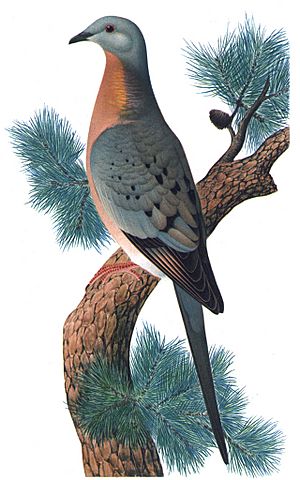
- Saint Helena dove, Dysmoropelia dekarchiskos (St. Helena, South Atlantic, 1500s?)
- Passenger pigeon, Ectopistes migratorius (eastern North America, 1914)
- This bird was once one of the most common birds in the world. People hunted it for food and sport. The last one, named Martha, died in a zoo in 1914.
- Bonin wood pigeon, Columba versicolor (Nakodo-jima and Chichi-jima, Ogasawara Islands, around 1890)
- Ryukyu wood pigeon, Columba jouyi (Okinawa and Daito Islands, Northwest Pacific, late 1930s)
- Rodrigues pigeon, Nesoenas rodericanus (Rodrigues, Mascarenes, before 1690?)
- Spotted green pigeon, Caloenas maculata (South Pacific or Indian Ocean islands, 1820s)
- Sulu bleeding-heart, Gallicolumba menagei (Tawitawi, Philippines, late 1990s?)
- This bird is officially critically endangered. It is known from only two specimens.
- Norfolk ground dove, Pampusana norfolciensis (Norfolk Island, Southwest Pacific, around 1800)
- Tanna ground dove, Pampusana ferruginea (Tanna, Vanuatu, late 1700s or 1800s)
- Thick-billed ground dove, Pampusana salamonis (Makira and Ramos, Solomon Islands, mid-1900s?)
- Last seen in 1927. Declared extinct in 2005.
- Choiseul pigeon, Microgoura meeki (Choiseul, Solomon Islands, early 1900s)
- Red-moustached fruit dove, Ptilinopus mercierii (Nuku Hiva and Hiva Oa, Marquesas, 1922)
- Negros fruit dove, Ptilinopus arcanus (Negros, Philippines, late 1900s?)
- This bird is officially critically endangered. It is known from only one specimen.
- Mauritius blue pigeon, Alectroenas nitidissima (Mauritius, Mascarenes, around 1830s)
- Réunion blue pigeon, Alectroenas sp. (Réunion, Mascarenes, 1619)
- Providence blue pigeon, Alectroenas sp. (Farquhar Group, Seychelles, 1800s)
- Dodo, Raphus cucullatus (Mauritius, Mascarenes, late 1600s)
- The dodo was a large, flightless bird from Mauritius. Its home was destroyed by Dutch settlers, and its nests and eggs were eaten by animals they brought. The last dodo died in 1681.
- Rodrigues solitaire, Pezophaps solitaria (Rodrigues, Mascarenes, around 1730)
Cuckoos (Cuculiformes)
- Delalande's coua, Coua delalandei (Madagascar, late 1800s?)
- Saint Helena cuckoo, Nannococcyx psix (St. Helena, South Atlantic, 1700s)
Vultures (Cathartiformes)
- "Painted vulture", Sarcoramphus sacra (Florida, North America, late 1700s?)
- This bird was described in the 1770s. Some people think it was a real species, while others think it was a mistake.
Owls (Strigiformes)
- Strigidae – These are true owls.
- Pernambuco pygmy owl, Glaucidium mooreorum (Pernambuco, Brazil, 2001?)
- This bird is officially critically endangered, but it might still exist.
- Réunion scops owl, Otus grucheti (Réunion, Mascarenes, late 1600s?)
- Mauritius scops owl, Otus sauzieri (Mauritius, Mascarenes, around 1850)
- Rodrigues scops owl, Otus murivorus (Rodrigues, Mascarenes, mid-1700s)
- Siau scops owl, Otus siaoensis (Siau Island, Indonesia, 1900s?)
- Known from only one specimen. It might still exist.
- New Caledonian boobook, Ninox cf. novaeseelandiae (New Caledonia, Melanesia)
- Known from old bones. It might still exist.
- Laughing owl, Ninox albifacies (New Zealand, 1914?)
- Tytonidae – These are barn owls.
- Puerto Rican barn owl, Tyto cavatica (Puerto Rico, West Indies, early 1900s?)
- Known from old bones. Stories suggest it might have lived until 1912.
Nightjars and Nighthawks (Caprimulgiformes)
- Caprimulgidae – These are nightjars and nighthawks.
- Jamaican poorwill, Siphonorhis americana (Jamaica, West Indies, late 1800s?)
- This bird is officially critically endangered, possibly extinct. It might still exist.
- Cuban pauraque, Siphonorhis daiquiri (Cuba, West Indies, prehistoric?)
- Known from old bones. Some people think it might still exist.
- Vaurie's nightjar, Caprimulgus centralasicus (China, early 1900s?)
- Known from only one specimen. Its existence is debated.
- New Caledonian nightjar, Eurostopodus exsul (New Caledonia, Melanesia, mid-1900s)
- Only found once. It might still exist, but it's unlikely.
Swifts and Hummingbirds (Apodiformes)
- Letitia's thorntail, Discosura letitiae (Bolivia?)
- Known from only three specimens. It might still exist.
- Brace's emerald, Riccordia bracei (New Providence, Bahamas, West Indies, late 1800s)
- Gould's emerald, Riccordia elegans (Jamaica or northern Bahamas, West Indies, late 1800s)
- Turquoise-throated puffleg, Eriocnemis godini (Ecuador, 1900s?)
- This bird is officially critically endangered, possibly extinct. Its home has been destroyed.
Kingfishers and Related Birds (Coraciiformes)
- Saint Helena hoopoe, Upupa antaois (St. Helena, South Atlantic, early 1500s)
- Guam kingfisher, Todirhmphus cinnamominus (Guam, West Pacific, 1986)
- This bird became extinct in the wild in 1986 because of brown tree snakes. Some birds are still in a breeding program.
Woodpeckers and Related Birds (Piciformes)
- Bermuda flicker, Colaptes oceanicus (Bermuda, West Atlantic, 1600s?)
- Known from old bones. An old report might refer to this bird.
- Imperial woodpecker, Campephilus imperialis (Mexico, late 1900s)
- This large woodpecker is officially critically endangered, possibly extinct. Some people still report seeing it.
- Ivory-billed woodpecker, Campephilus principalis (southeastern United States and Cuba, late 1900s)
- The American ivory-billed woodpecker is officially critically endangered and possibly extinct. The Cuban ivory-billed woodpecker is generally considered extinct.
Birds of Prey (Falconiformes)
- Guadalupe caracara, Caracara lutosa (Guadalupe, East Pacific, 1900 or 1903)
- Réunion kestrel, Falco duboisi (Réunion, Mascarenes, around 1700)
Parrots (Psittaciformes)

- Sinú parakeet, Pyrrhura subandina (Colombia, mid-1900s?)
- This bird was last seen in 1949 and seems to be extinct.
- Norfolk kākā, Nestor productus (Norfolk and Philip Islands, Southwest Pacific, 1851?)
- Society parakeet, Cyanoramphus ulietanus (Raiatea, Society Islands, South Pacific, late 1700s)
- Black-fronted parakeet, Cyanoramphus zealandicus (Tahiti, Society Islands, South Pacific, around 1850)
- Lord Howe parakeet, Cyanorhamphus subflavescens (Lord Howe Island, Southwest Pacific, around 1870)
- Macquarie parakeet, Cyanoramphus erythrotis (Macquarie Islands, Southwest Pacific, 1890s)
- Paradise parrot, Psephotellus pulcherrimus (Rockhampton area, Australia, late 1920s)
- Oceanic eclectus, Eclectus infectus (Tonga, Vanuatu, possibly Fiji, 1700s or later?)
- New Caledonian lorikeet, Vini diadema (New Caledonia, Melanesia, mid-1900s?)
- This bird is officially critically endangered. It is small and hard to find.
- Seychelles parakeet, Psittacula wardi (Seychelles, West Indian Ocean, 1883)
- Newton's parakeet, Psittacula exsul (Rodrigues, Mascarenes, around 1875)
- Mascarene grey parakeet, Psittacula bensoni (Mauritius, possibly Réunion, 1760s)
- Mascarene parrot, Mascarinus mascarinus (Réunion and possibly Mauritius, Mascarenes, 1834?)
- Broad-billed parrot, Lophopsittacus mauritianus (Mauritius, Mascarenes, 1680?)
- Rodrigues parrot, Necropsittacus rodericanus (Rodrigues, Mascarenes, late 1700s)
- Glaucous macaw, Anodorhynchus glaucus (northern Argentina, early 1900s)
- This bird is officially critically endangered, but it is probably extinct.
- Cuban macaw, Ara tricolor (Cuba, late 1800s)
- Carolina parakeet, Conuropsis carolinensis (southeastern North America, around 1930?)
- The last one in captivity died in 1918, but some wild ones might have lived longer.
- Guadeloupe parakeet, Psittacara labati (Guadeloupe, West Indies, late 1700s)
- Martinique amazon, Amazona martinica (Martinique, West Indies, mid-1700s)
- Guadeloupe amazon, Amazona violacea (Guadeloupe, West Indies, mid-1700s)
Perching Birds (Passeriformes)
- Tyrannidae – These are tyrant flycatchers.
- San Cristóbal flycatcher, Pyrocephalus dubius (San Cristóbal Island, Galápagos Islands, late 1900s)
- This bird was very rare and has not been found since 1998.
- Furnariidae – These are ovenbirds.
- Cryptic treehunter, Cichlocolaptes mazarbarnetti (eastern Brazil, 2007)
- Alagoas foliage-gleaner, Philydor novaesi (eastern Brazil, 2011)
- Acanthisittidae – These are New Zealand "wrens."
- Lyall's wren, Traversia lyalli (New Zealand, 1895?)
- This flightless bird was said to have been wiped out by one lighthouse keeper's cat.
- Bushwren, Xenicus longipes (New Zealand, 1972)
- Mohoidae – These are Hawaiian honeyeaters.
- Kioea, Chaetoptila angustipluma (Big Island, Hawaiian Islands, 1860s)
- Hawaiʻi ʻōʻō, Moho nobilis (Big Island, Hawaiian Islands, 1930s)
- Oʻahu ʻōʻō, Moho apicalis (Oʻahu, Hawaiian Islands, mid-1800s)
- Bishop's ʻōʻō, Moho bishopi (Molokaʻi and probably Maui, Hawaiian Islands, around 1910 or 1980s)
- Kauaʻi ʻōʻō, Moho braccatus (Kauaʻi, Hawaiian Islands, 1987)
- Meliphagidae – These are honeyeaters.
- Chatham bellbird, Anthornis melanocephala (Chatham Islands, Southwest Pacific, around 1910)
- Acanthizidae – These are scrubwrens and gerygones.
- Lord Howe gerygone, Gerygone insularis (Lord Howe Island, Southwest Pacific, around 1930)
- Pachycephalidae – These are whistlers and allies.
- Mangarevan whistler, ?Pachycephala gambierana (Mangareva, Gambier Islands, South Pacific, late 1800s?)
- A mysterious bird with no specimens left.
- Dicruridae – These are monarch flycatchers and allies.
- Maupiti monarch, Pomarea pomarea (Maupiti, Society Islands, South Pacific, mid-1800s)
- Eiao monarch, Pomarea fluxa (Eiao, Marquesas, late 1970s)
- Nuku Hiva monarch, Pomarea nukuhivae (Nuku Hiva, Marquesas, mid- to late 1900s)
- Ua Pou monarch, Pomarea mira (Ua Pou, Marquesas, around 1986)
- Guam flycatcher, Myiagra freycineti (Guam and Marianas, West Pacific, 1983)
- Oriolidae – These are Old World orioles and allies.
- North Island piopio, Turnagra tanagra (North Island, New Zealand, around 1970?)
- Not seen for sure since about 1900.
- South Island piopio, Turnagra capensis (South Island, New Zealand, 1960s?)
- Usually thought to be extinct.
- Corvidae – These are crows, ravens, and jays.
- Hawaiian crow, Corvus hawaiiensis (Big Island, Hawaiian Islands, 2002)
- This species is extinct in the wild, but some are still alive in captivity.
- Callaeidae – These are New Zealand wattlebirds.
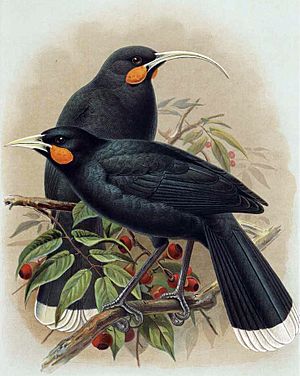
-
- Huia, Heteralocha acutirostris (North Island, New Zealand, early 1900s)
- South Island kokako, Callaeas cinereus (South Island, New Zealand, 1960s?)
- Usually thought to be extinct, but some recent reports suggest it might still exist.
- Hirundinidae – These are swallows and martins.
- White-eyed river martin, Pseudochelidon sirintarae (Thailand, late 1980s?)
- This bird is officially critically endangered. It was last seen in 1986.
- Red Sea cliff swallow, Petrochelidon perdita (Red Sea area, late 1900s?)
- Known from only one specimen. It might still exist.
- Acrocephalidae – These are reed warblers.
- Nightingale reed warbler, Acrocephalus luscinius (Guam, West Pacific, around 1970s)
- Pagan reed warbler, Acrocephalus yamashinae (Pagan, Marianas, West Pacific, 1970s)
- Aguiguan reed warbler, Acrocephalus nijoi (Aguiguan, Marianas, West Pacific, around 1997)
- Mangareva reed warbler, Acrocephalus astrolabii (Marianas?, West Pacific, mid-1800s?)
- Known from only two specimens.
- Garrett's reed warbler, Acrocephalus musae (Raiatea and Huahine, Society Islands, South Pacific, 1800s?)
- Moorea reed warbler, Acrocephalus longirostris (Moorea, Society Islands, South Pacific, 1980s?)
- The last reliable sighting was in 1981.
- Muscicapidae – These are Old World flycatchers and chats.
- Rück's blue flycatcher, Cyornis ruckii (Malaysia or Indochina, 1900s?)
- Known from only a few specimens. It might still exist.
- Megaluridae – These are grass warblers.
- Chatham fernbird, Poodytes rufescens (Chatham Islands, Southwest Pacific, around 1900)
- Cisticolidae – These are cisticolas and allies.
- Tana River cisticola, Cisticola restrictus (Kenya, Africa, 1970s?)
- A mysterious bird not seen since 1972.
- Zosteropidae – These are white-eyes.
- Marianne white-eye, Zosterops semiflavus (Marianne Island, Seychelles, late 1800s)
- Robust white-eye, Zosterops strenuus (Lord Howe Island, Southwest Pacific, around 1918)
- White-chested white-eye, Zosterops albogularis (Norfolk Island, Southwest Pacific, between 2006 and 2010)
- Pycnonotidae – These are bulbuls.
- Rodrigues bulbul, Hypsipetes cowlesi (Rodrigues, Mascarenes, extinction date unknown, 1600s or 1700s possible)
- Known only from old bones.
- Sylvioidea incertae sedis
- Aldabra brush warbler, Nesillas aldabrana (Aldabra, Indian Ocean, around 1984)
- Rodrigues "babbler" (Rodrigues, Mascarenes, 1600s?)
- Known only from old bones.
- Sturnidae – These are starlings.
-
- Kosrae starling, Aplonis corvina (Kosrae, Caroline Islands, West Pacific, mid-1800s)
- Mauke starling, Aplonis mavornata (Mauke, Cook Islands, mid-1800s)
- Tasman starling, Aplonis fusca (Norfolk Island and Lord Howe Island, Southwest Pacific, around 1923)
- Pohnpei starling, Aplonis pelzelni (Pohnpei, Micronesia, around 2000)
- Only one reliable record since 1956.
- Raiatea starling, Aplonis? ulietensis (Raiatea, Society Islands, South Pacific, between 1774 and 1850)
- A mysterious bird known only from a painting.
- Hoopoe starling, Fregilupus varius (Réunion, Mascarenes, 1850s)
- Rodrigues starling, Necropsar rodericanus (Rodrigues, Mascarenes, mid-1700s?)
- Turdidae – These are thrushes and allies.
- Grand Cayman thrush, Turdus ravidus (Grand Cayman, West Indies, late 1940s)
- Bonin thrush, Zoothera terrestris (Chichi-jima, Ogasawara Islands, around 1830s)
- Kāmaʻo, Myadestes myadestinus (Kauaʻi, Hawaiian Islands, 1990s)
- Olomaʻo, Myadestes lanaiensis (Hawaiian Islands, 1980s?)
- This bird is officially critically endangered because one possible location has not been checked.
- Mimidae – These are mockingbirds and thrashers.
- Cozumel thrasher, Toxostoma guttatum (Cozumel, West Indies, early 2000s?)
- It's unknown if this bird survived hurricanes in 2005.
- Estrildidae – These are estrildid finches.
- Black-lored waxbill, Estrilda nigriloris (Democratic Republic of the Congo, Africa, late 1900s?)
- A mysterious bird not seen since 1950.
- Icteridae – These are New World blackbirds and allies.
- Slender-billed grackle, Quiscalus palustris (Mexico, 1910)
- Parulidae – These are New World warblers.
- Bachman's warbler, Vermivora bachmanii (southern United States, around 1990?)
- This bird is officially critically endangered.
- Semper's warbler, Leucopeza semperi (St. Lucia, West Indies, 1970s?)
- This bird is officially critically endangered.
- Ploceidae – These are weavers.
- Réunion fody, Foudia delloni (Réunion, Mascarenes, around 1672)
- Fringillidae – These are true finches and Hawaiian honeycreepers.
- Bonin grosbeak, Carpodacus ferreorostris (Chichi-jima, Ogasawara Islands, 1830s)
- ʻŌʻū, Psittirostra psittacea (Hawaiian Islands, around 2000?)
- This bird is officially critically endangered. It was once very common.
- Kona grosbeak, Chloridops kona (Big Island, Hawaiian Islands, 1894)
- Lanaʻi hookbill, Dysmorodrepanis munroi (Lanaʻi, Hawaiian Islands, 1918)
- Kauaʻi palila, Loxioides kikuichi (Kauaʻi, Hawaiian Islands, early 1700s?)
- Lesser koa finch, Rhodacanthus flaviceps (Big Island, Hawaiian Islands, 1891)
- Greater koa finch, Rhodacanthus palmeri (Big Island, Hawaiian Islands, 1896)
- Greater ʻamakihi, Viradonia sagittirostris (Big Island, Hawaiian Islands, 1901)
- Maui nukupuʻu, Hemignathus affinis (Maui, Hawaiian Islands, 1990s)
- Kauaʻi nukupuʻu, Hemignathus hanapepe (Kauaʻi, Hawaiian Islands, late 1990s)
- Oʻahu nukupuʻu, Hemignathus lucidus (Oʻahu, Hawaiian Islands, late 1800s)
- Hawaiʻi ʻakialoa or lesser ʻakialoa, Akialoa obscurus (Big Island, Hawaiian Islands, 1940)
- Maui Nui ʻakialoa, Akialoa lanaiensis (Lanaʻi and, long ago, probably Maui and Molokaʻi, Hawaiian Islands, 1892)
- Oʻahu ʻakialoa, Akialoa ellisiana (Oʻahu, Hawaiian Islands, early 1900s)
- Kauaʻi ʻakialoa, Akialoa stejnegeri (Kauaʻi, Hawaiian Islands, 1969)
- Kākāwahie, Paroreomyza flammea (Molokaʻi, Hawaiian Islands, 1963)
- Oʻahu ʻalauahio, Paroreomyza maculata (Oʻahu, Hawaiian Islands, early 1990s?)
- This bird is officially critically endangered. The last reliable sighting was in 1985.
- Maui ʻakepa, Loxops ochraceus (Maui, Hawaiian Islands, 1988)
- Oʻahu ʻakepa, Loxops wolstenholmei (Oʻahu, Hawaiian Islands, 1900s)
- ʻUla-ʻai-hawane, Ciridops anna (Big Island, Hawaiian Islands, either 1892 or 1937)
- Black mamo, Drepanis funerea (Molokaʻi, Hawaiian Islands, 1907)
- Hawaii mamo, Drepanis pacifica (Big Island, Hawaiian Islands, 1898)
- Laysan honeycreeper, Himatione fraithii (Laysan, Hawaiian Islands, 1923)
- Poʻoʻouli, Melamprosops phaeosoma (Maui, Hawaiian Islands, 2004)
- Emberizidae – These are buntings and New World sparrows.
- Hooded seedeater, Sporophila melanops (Brazil, 1900s?)
- This bird is officially critically endangered. It is known from only one male specimen.
- Bermuda towhee, Pipilo naufragus (Bermuda, West Atlantic, 1600s?)
- Known from old bones.
Images for kids
See also
 In Spanish: Anexo:Aves extintas para niños
In Spanish: Anexo:Aves extintas para niños


